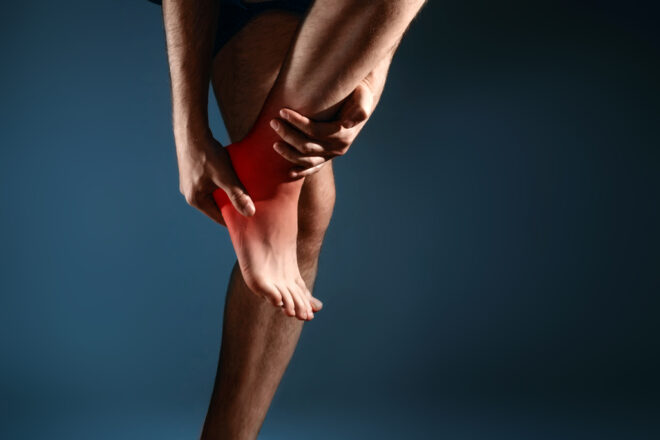Have you been experiencing heel pain after running? Maybe ankle pain too?
Waking up with a sore heel happens to many runners at some point. It’s one of the most common types of foot pain caused by running.
Most of the time, there’s nothing to be concerned about. You might have a runner’s heel or some similar issue. However, it’s critical to understand the reasons to address the symptoms before they progress.
Read on to find out more about how to treat and prevent heel pain after running.
In This Article:
What Causes Heel Pain After Running?
Heel pain after running can have multiple causes. These include plantar fasciitis (also known as a runner’s heel), structural issues, poor foot strike, nerve irritation, and other diseases.
Back heel pain after running or pain in the foot’s arch are common signs of plantar fasciitis. Also, if you have a bruised heel, it may indicate you’ve been overtraining.
Heel bruising occurs as a result of your heel bone hitting a hard surface. It’s more likely to happen if you don’t wear good running shoes.
You may wonder, “Why does my heel hurt after running? Why didn’t I get heel pain when running?”
The fibrous, collage tendons and connective tissue (fascia) surrounding the heel bone tear when running and then repair themselves overnight. Pain occurs when collagen fibers don’t have enough time to heal. In the morning, when putting weight on your foot, the collagen fibers that don’t have time to heal properly tear again. Hence the sharp morning pain.
Plantar fasciitis
Plantar fasciitis affects around 10% of runners. For some runners, it may be a recurrent problem.
The condition occurs when the rope-like tendon connecting the heel to the ball of the foot becomes inflamed. It may happen because of overuse, overstretching, tearing, or injury.
Other symptoms can include swelling and redness in the area and a stiff heel. If you feel sharp foot pain in the morning, it’s usually plantar fasciitis.
Running with plantar fasciitis is possible if the pain is mild, but it’s not a good idea. Better give your fascia a few weeks to heal before putting repeated strain on your foot again.
Structural issues
The strain on the foot ligaments and muscles can lead to the development of heel spurs. These are body calcium deposits on the underside of the calcaneus bone. Having plantar fasciitis can lead to bone spurs as your body tries to provide more support for the foot.
The arches of your feet absorb shock. Some runners are born with high arches, fallen arches, or flat feet. These lead to less shock absorption than normal. As a result, they increase the strain on the connective tissue in the foot.
Structural issues in the hip or knee can also lead to heel pain after running. The same is true for weak supporting leg muscles, like those in the calves.
You can correct some structural issues, such as heel spurs, with surgery. For others, orthotics and the right running shoes may help.
Poor foot strike
Uneven terrain, overtraining, or bad running technique can lead to additional strain on your feet. Landing heel-first can contribute to the problem. But changing your strike pattern to mid-foot or forefoot strike isn’t beneficial, according to this study. On the contrary, it can put more strain on your foot and knee.
Your pronation type can also cause heel pain. Pronation refers to how your foot rolls inward to distribute the impact of striking the ground. There are three pronation types: underpronation, overpronation, and neutral.
In underpronation and overpronation, the foot rolls outward or inward from the ankle. It puts more pressure on your foot and can contribute to running injuries, including heel pain. You can compensate for these by choosing appropriate running shoes.
Other causes
Less frequently, heel pain after running appears because of one of the following conditions:
- Sever’s disease, a condition causing inflammation of the heel bone growth plate
- Achilles tendonitis, commonly caused by overuse of the tendon connecting the heel bone to the calf muscles
- Arthritis affecting the heel bone, potentially leading to bone and nerve pain
- Nerve irritation, which occurs when nerves in the heel become compressed or trapped because of injury or overuse
How to Treat Heel Pain After Running
Treating heel pain immediately after it appears can make it go away sooner. It may also enable you to return to normal running faster.
Rolling massage
Tennis ball or golf ball rolls stretch and loosen up the muscles and connective tissue in the foot. Place the ball under your foot arch and roll it around, putting weight on the ball. You can do this exercise standing or seated.
Tape the foot
Tape your arches with athletic tape to provide them with more support. Taping can help lessen heel pain. It can also prevent other overuse running injuries.
Research indicates that using kinesiology tape as part of massage therapy reduces plantar fasciitis pain. You may want to try it too. Note that kinesiology tape is thin and elastic, unlike athletic tape, which is inflexible.
Rest
Rest is often the best way to deal with mild to moderate heel pain after running. You need to give your tissue time to repair, which won’t happen if you keep on running.
Take a break from running and wait for the symptoms to go away before hitting the ground again. Meanwhile, you can do stretching exercises for the feet and calves.
Reduce inflammation and pain
Start with an ice pack. Place it on your knee for 20 minutes twice a day.
You can treat mild heel pain with natural pain relieves like cloves, turmeric, and fish oil. These have anti-inflammatory properties. You can add powdered cloves to soups, drink turmeric tea, and take a fish oil supplement. You can also try supplements with turmeric and clove extracts.
Other ways to treat mild heel pain include taking aspirin and anti-inflammatory drugs such as ibuprofen.
Use heel pads or orthotic inserts
Orthotic inserts and heel pads provide support and reduce the strain on your foot. You can start using them for walking if the pain is bad. You can also add them to your running shoes.
Night splints
Night splints help with heel pain from plantar fasciitis, according to this study. Sleeping with your feet pointed can shorten collagen fibers, causing sharp pain in the morning. Night splints keep your tendons gently stretched, improving their alignment, and encouraging them to lengthen during recovery.
After waking, you can use supporting slippers to reduce the strain on your feet. You can also stretch the tissues before getting down from the bed using a simple towel stretch.
As you sit with your knee straight, loop a towel around your foot. Pull on the towel gently so that you feel the stretch in your calf. Maintain the stretch for 30 seconds.
How to Prevent Heel Pain After Running
Preventing heel pain after running is better than having to treat it. And there’s a lot you can do to avoid heel pain.
First and foremost, you don’t want to overtrain. Following a running plan adapted to your fitness level and goals will challenge you to improve without the risk of running injuries.
There are a couple of other things you should pay attention to.
Improve footstrike patterns
Heel striking can make you more susceptible to certain running injuries. For example, heel strikers are twice more likely to develop repetitive stress injuries. But forefoot and midfoot running can also cause heel pain.
As we’ve seen already, changing your footstrike pattern isn’t necessarily the best approach. But you can improve your current footstrike pattern.
Pay attention to what part of your foot hits the ground first. Is it your heel? A rearfoot strike pattern can lead to heel bruising and pain.
Consider adjusting your pattern so that your foot lands more midfoot or forefoot without completely changing it.
Warm up and stretch properly
Stretching the plantar fascia and calves makes it easier to manage heel pain, according to this study. It may also help prevent pain in the first place.
As a rule, you want to warm up properly and stretch your tendons and muscles before hitting the ground running.
Combine foot stretches with ankle stretches and calf stretches for the best results. This way, you’ll prepare your lower legs for the strain that’s to come.
Start with simple stretches like grabbing your toes and pulling them toward your ankle. With your other hand, massage the arch of your foot. Hold the position for 10 seconds and repeat 10 times.
Maintain a healthy body weight
When running, the connective tissue in the foot decelerates the impact of up to 10 times your body weight. That’s a lot.
Maintaining a healthy body weight puts less pressure on your feet. Good running starts with healthy meals that help you build muscles.
Eat healthy fats and protein following the Healthy Plate method and minimize processed foods and sugary drinks.
Get supportive shoes for your feet
The right running shoes can help prevent heel pain and many other running injuries.
The best running shoes for plantar fasciitis feel comfortable. They provide support and cushioning and hold your heel in place as you run without altering your gait.
Look for shoes that support your foot arch without adding in unnecessary cushioning, which can make running injuries worse.
You want your running shoes to cradle your feet but still be able to feel the ground under your soles. Not feeling the ground when running due to excessive cushioning may make you slack about your strike pattern and running form.
Takeaway
In the end, here’s a quick recap of the main points we’ve discussed so far, including how to treat heel pain after running.
- Heel pain after running can have different causes, including plantar fasciitis, poor foot strike, structural issues, nerve compression, or arthritis.
- The fibrous, rope-like connective tissue around your heel repairs itself constantly. You need good sleep to promote healing.
- In addition to rest, you can treat heel pain after running through rolling massages, taping the foot, and icing. Natural pain relievers, heel pads, orthotic inserts, and wearing night splints can also help.
- Preventing heel pain gets easier if you warm up and stretch properly, mind your footstrike pattern, and maintain healthy body weight.
- Wearing supportive running shoes makes preventing and managing heel pain easier.
- Heel pain is often the result of overtraining.
- Consider following a personalized running plan to get the most out of every run while minimizing the risk of injury.














